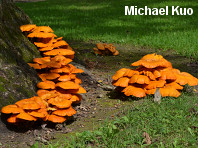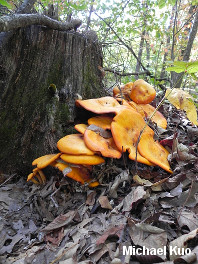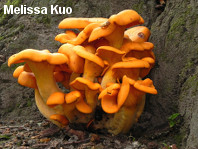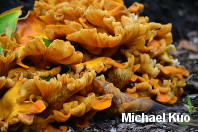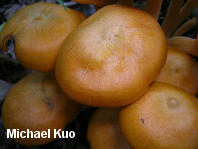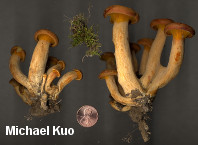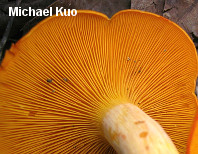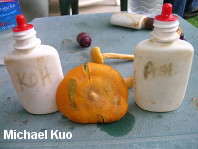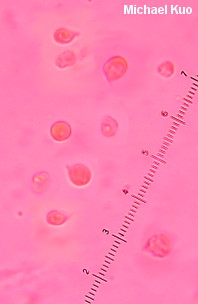| Major Groups > Gilled Mushrooms > Pale-Spored > Clitocyboid > Omphalotus illudens |

|
[ Basidiomycota > Agaricales > Omphalotaceae > Omphalotus . . . ] Omphalotus illudens by Michael Kuo, 8 September 2023 Often called the "Jack O'Lantern Mushroom," this species is fairly easy to identify. It grows in clusters on wood, its colors are bright orange, its gills run down the stem, it has a white to pale yellow spore print, and its flesh, when sliced open, is orange (or at least orangish). In North America it is a common fall mushroom east of the Rocky Mountains, and is frequently found in urban settings, sprouting from and around dead trees and stumps. In Europe it is a northern and north-temperate species, replaced in southern Europe by Omphalotus olearius. In California Omphalotus illudens is replaced by Omphalotus olivascens, which often features olive shades mixed in with the orange. The Jack O'Lantern mushroom is sometimes confused with chanterelles—especially when it appears to be growing terrestrially rather than from wood (see the top illustration). However, chanterelles rarely grow in dense clusters, and feature false gills, while the Jack O'Lantern is usually clustered and features true gills. Description: Ecology: Saprobic; growing in large clusters on the stumps or buried roots of hardwoods, especially oaks; late summer and fall; originally described from North Carolina (von Schweinitz, 1822); in North America widely distributed east of the Rocky Mountains and in Mexico; also distributed in northern and north-temperate Europe. The illustrated and described collections are from Illinois. Cap: 3–20 cm; at first convex, with a central bump or point; becoming more or less flat, and eventually shallowly vase-shaped—but usually retaining a small central "nipple"; bald; dry or slightly greasy; bright orange to pumpkin orange; the margin inrolled when young. Gills: Running down the stem; close or crowded; bright orange to pale orange; short-gills frequent; luminescent when fresh. Stem: 3–13 cm long; 1–2 cm thick; tapering to base; solid; bald; pale orange to orange. Flesh: Pale orange; unchanging when sliced. Odor: Not distinctive. Chemical Reactions: KOH green on cap surface; ammonia greenish on cap surface. Spore Print: White to creamy or pale yellow. Microscopic Features: Spores 3.5–4.5 µm; subglobose; smooth; hyaline to yellowish in KOH; inamyloid. Cystidia not found. Pileipellis a cutis of clamped, cylindric elements 2.5–7.5 µm wide; yellow in KOH. Refractive elements scattered to frequent in the pileipellis and subpellis. REFERENCES: (L. D. von Schweinitz, 1822) A. Bresinsky & H. Besl, 1979. (Kauffman, 1918; Smith, Smith & Weber, 1979; Weber & Smith, 1985; Arora, 1986; Phillips, 1991/2005; Lincoff, 1992; Metzler & Metzler, 1992; Horn, Kay & Abel, 1993; Kuyper, 1995; Barron, 1999; Kirchmair & Pöder, 2002; Kirchmair et al., 2002; Roody, 2003; Kirchmair et al., 2004; McNeil, 2006; Miller & Miller, 2006; Binion et al., 2008; Kuo & Methven, 2010; Buczacki et al., 2013; Kuo & Methven, 2014; Knudsen, 2018; Læssøe & Petersen, 2019; Kibby, 2020.) Herb. Kuo 08309701, 07290701, 08231404. This site contains no information about the edibility or toxicity of mushrooms. |
© MushroomExpert.Com |
|
Cite this page as: Kuo, M. (2023, September). Omphalotus illudens. Retrieved from the MushroomExpert.Com Web site: http://www.mushroomexpert.com/omphalotus_illudens.html |
